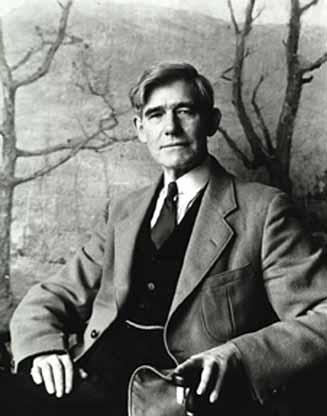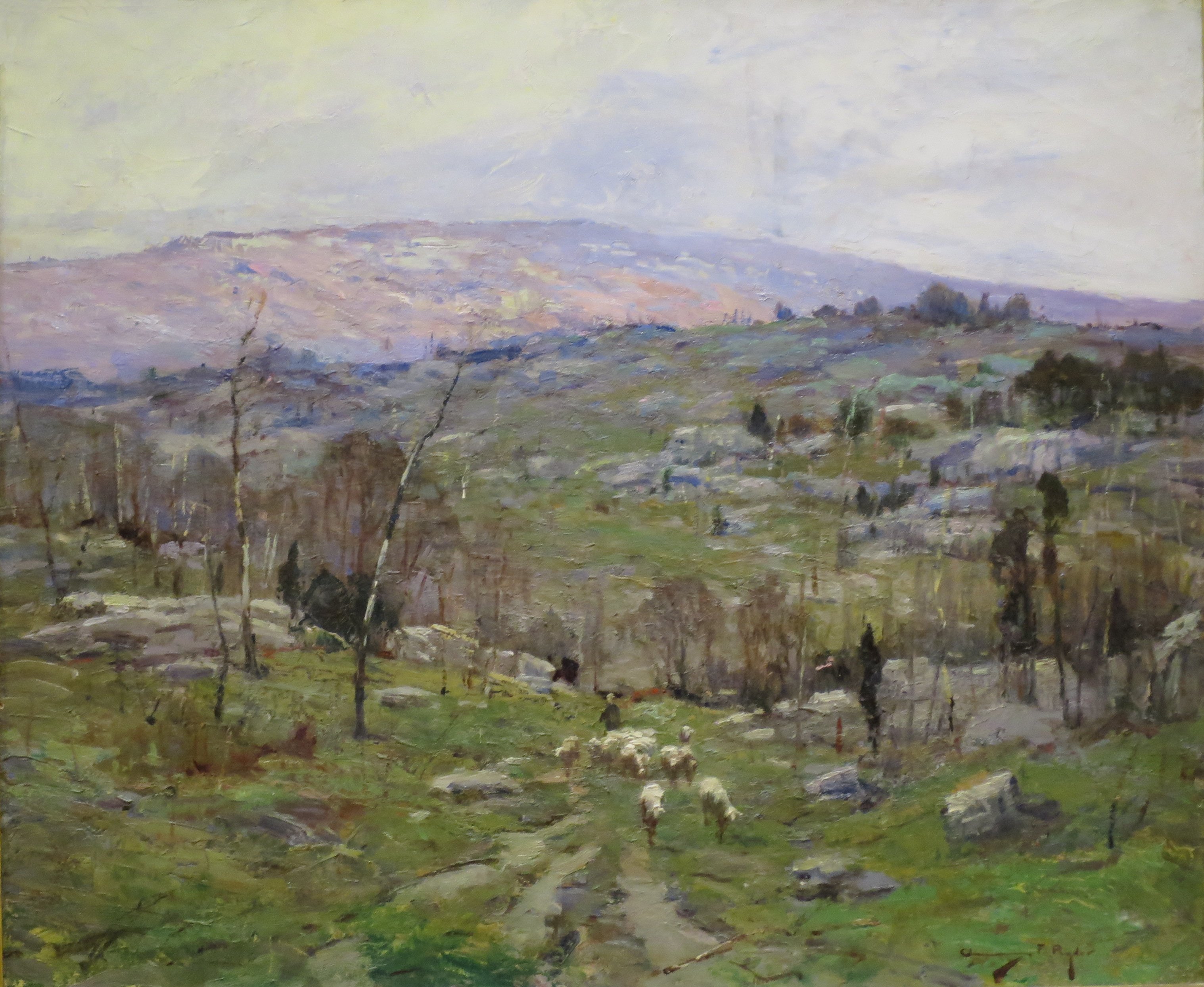Chauncey Foster Ryder on:
[Wikipedia]
[Google]
[Amazon]
 Chauncey Foster Ryder (29 February 1868 – 18 May 1949)
Chauncey Foster Ryder (29 February 1868 – 18 May 1949)listing @ Ancestry.com
/ref> was an early 20th century American Postimpressionist landscape painter known for a green-gray palette termed 'Ryder green'.
 In 1907, Ryder moved to New York City, where he was represented for the rest of his career by art dealer William Macbeth. His landscapes were admired for their vigorous brushwork, and the degree to which he pushed representational elements towards abstraction. He became known for a palette of predominantly gray-green tones, eventually known as 'Ryder green'.
Ryder created many works in oil and watercolor. Around 1910 he began making prints, including
In 1907, Ryder moved to New York City, where he was represented for the rest of his career by art dealer William Macbeth. His landscapes were admired for their vigorous brushwork, and the degree to which he pushed representational elements towards abstraction. He became known for a palette of predominantly gray-green tones, eventually known as 'Ryder green'.
Ryder created many works in oil and watercolor. Around 1910 he began making prints, including  Ryder died in Wilton in 1949. His work is in the collections of numerous American museums, including the
Ryder died in Wilton in 1949. His work is in the collections of numerous American museums, including the
More works by Ryder
@ ArtNet
{{DEFAULTSORT:Ryder, Chauncey Foster 1868 births 1949 deaths 20th-century American painters American male painters American landscape painters People from Danbury, Connecticut Painters from Connecticut 20th-century American male artists
 Chauncey Foster Ryder (29 February 1868 – 18 May 1949)
Chauncey Foster Ryder (29 February 1868 – 18 May 1949)/ref> was an early 20th century American Postimpressionist landscape painter known for a green-gray palette termed 'Ryder green'.
Education and personal life
Ryder was born in 1868 in Danbury, Connecticut, but grew up mainly in New Haven. He began studying painting as a boy. In his early twenties, he moved to Chicago to attend the Art Institute, then Smith's Academy. After only a year at the latter, he was hired as an instructor. In 1891, he married Mary Dole Keith. In 1901, they moved to Paris, France, where Ryder continued his art education, studying withJean-Paul Laurens
Jean-Paul Laurens (; 28 March 1838 – 23 March 1921) was a French painter and sculptor, and one of the last major exponents of the French Academic style.
Biography
Laurens was born in Fourquevaux and was a pupil of Léon Cogniet and Alexa ...
at the Académie Julian. Ryder stayed in France for several years, living in an art colony at Étaples
Étaples or Étaples-sur-Mer (; vls, Stapel, lang; pcd, Étape) is a commune in the Pas-de-Calais department in northern France. It is a fishing and leisure port on the Canche river.
History
Étaples takes its name from having been a medieval ...
and exhibiting his work at the Paris Salon (1903–1909). He took on occasional students, including American painter William Posey Silva. His developing style was influenced by the dramatic compositions of his friend, painter Max Bohm, and by his admiration for the Japanese artist Hokusai.
Career
lithographs
Lithography () is a planographic method of printing originally based on the immiscibility of oil and water. The printing is from a stone (lithographic limestone) or a metal plate with a smooth surface. It was invented in 1796 by the German a ...
, etchings
Etching is traditionally the process of using strong acid or mordant to cut into the unprotected parts of a metal surface to create a design in intaglio (incised) in the metal. In modern manufacturing, other chemicals may be used on other types ...
, and drypoint
Drypoint is a printmaking technique of the intaglio family, in which an image is incised into a plate (or "matrix") with a hard-pointed "needle" of sharp metal or diamond point. In principle, the method is practically identical to engraving. The ...
s. His best drypoints exhibit great economy of line.
He opened a studio in the city in 1909, and the following year bought property in Wilton, New Hampshire. For the remainder of his life, he divided his time between New York and New Hampshire.
In 1910, he traveled throughout New England, providing locales for many of his subsequent paintings. That year, future president Woodrow Wilson
Thomas Woodrow Wilson (December 28, 1856February 3, 1924) was an American politician and academic who served as the 28th president of the United States from 1913 to 1921. A member of the Democratic Party, Wilson served as the president of ...
and his wife Ellen bought one of his landscapes, ''Valley of Assisi'', to celebrate their 25th wedding anniversary.
Ryder was a member of several art associations, including the American Water Color Society and the Society for Sanity in Art. Among his awards were the Paris Salon (honorable mention, 1907), the American Water Color Society
The American Watercolor Society, founded in 1866, is a nonprofit membership organization devoted to the advancement of watercolor painting in the United States.
Qualifications
AWS judges the work of a painter before granting admission to the soc ...
(gold medal), the National Arts Club (gold medal), and the New York Water Color Society (gold medal). He also received awards at the 1915 Panama–Pacific International Exposition
The Panama–Pacific International Exposition was a world's fair held in San Francisco, California, United States, from February 20 to December 4, 1915. Its stated purpose was to celebrate the completion of the Panama Canal, but it was widely s ...
and the 1937 Paris International Exposition.
 Ryder died in Wilton in 1949. His work is in the collections of numerous American museums, including the
Ryder died in Wilton in 1949. His work is in the collections of numerous American museums, including the Metropolitan Museum of Art
The Metropolitan Museum of Art of New York City, colloquially "the Met", is the largest art museum in the Americas. Its permanent collection contains over two million works, divided among 17 curatorial departments. The main building at 1000 ...
(New York), the Corcoran Gallery of Art
The Corcoran Gallery of Art was an art museum in Washington, D.C., United States, that is now the location of the Corcoran School of the Arts and Design, a part of the George Washington University.
Overview
The Corcoran School of the Arts & Design ...
and the National Portrait Gallery (Washington, D.C.), the Art Institute of Chicago (Illinois), and the Baltimore Museum of Art
The Baltimore Museum of Art (BMA) in Baltimore, Maryland, United States, is an art museum that was founded in 1914. The BMA's collection of 95,000 objects encompasses more than 1,000 works by Henri Matisse anchored by the Cone Collection of ...
(Maryland).
References
Further reading
* Pisano, Ronald G. "Chauncey Foster Ryder: Peace and Plenty." ''Art and Antiques'' (September–October 1978), pp. 76–83.External links
More works by Ryder
@ ArtNet
{{DEFAULTSORT:Ryder, Chauncey Foster 1868 births 1949 deaths 20th-century American painters American male painters American landscape painters People from Danbury, Connecticut Painters from Connecticut 20th-century American male artists